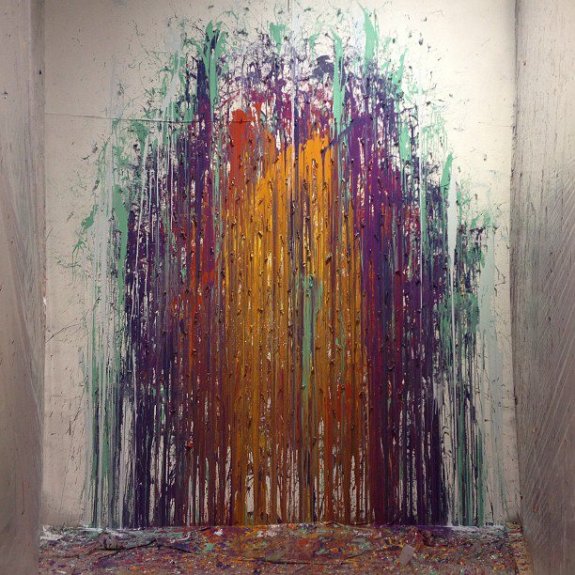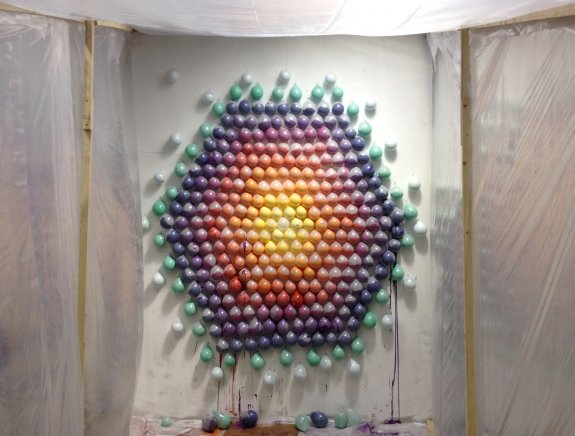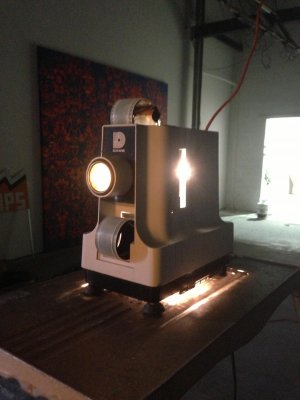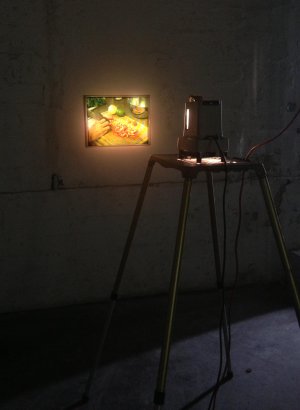 Hugo Montoya "Cause Living Just Isn't Enough" at Guccivuitton
Hugo Montoya "Cause Living Just Isn't Enough" at Guccivuitton
 Interview with Kazilla
Interview with Kazilla
The Collabo Show - Back by Popular Demand
“The Collabo Show” was “Back by Popular Demand” for one night only in a warehouse space in Wynwood. Part of a series of one day exhibitions dedicated to collaborative engagements among artists “The Collabo” featured more than 100 Miami-based artists like Bhakti Baxter, Agustina Woodgate, Johnny Robles, Sinisa Kukec, Onajide Shabaka, Franky Cruz, Gustavo Oviedo, Magnus Sodamin, David Rohn and Hugo Montoya.
The forth installment of the artist-run exhibitions that began in 2005 brought together artists with a wide range of practices. Engaging, interactive and experimental the art in “The Collabo” was all about enjoying art for art’s sake. The audience was invited to participate and immerse themselves and essentially become collaborators in creating a truly artistic, creative and self-exploratory experience.
Originally conceived after spontaneous collaborations at dinner parties the event always takes place in the middle of the blistering Miami summer hosted in a different space each time. Selected artists are encouraged to challenge their individual practices and enter a realm of co-experimentation. As a result, the majority of the works have been performative and interactive in nature, culminating into a vibrant and jovial happening.
The art engaged and involved the viewer on different levels. Some pieces were very personal, solitary experiences that fostered a one-on-one interaction between art and viewer, whilst other pieces were geared towards interactive, shared group experiences.
Sodamin’s project “Illuminations” aimed to explore a collaboration between painting performance, light and sound. Painted dancers Katie Stirman and Jenna Balfe were immersed in a large-scale Day-Glo painted background through movement and interaction with each other to the sound of echoing guitar loops. Movements were minimal as the dancers responded to each others gestures, never physically touching yet connected in movement and spirit. Says Sodamin, “Through patterns of repetition the piece brings focus on mimicry in nature and the animal instinct to change and adapt to the environment.” He adds, “As the large rorschach patterns in the background seem to reference spinal or pelvic areas, the dancers float the idea of their personal space and structure. Both, innocent and daring, the piece years to call to a primal past from which man has emerged..”
"Ive been trying to reverse the state of childhood into adulthood with some of my works. Also attempting to retrace ambiguous memories or feelings of my childhood and my fascination with science and nature. It starts out with daydreaming, which most adults don’t do anymore, instead play in there minds. I thought it would be appropriate to create something where people can play out loud for others as well for themselves to experience.”
The most popular piece of the night was a collaboration between Johnny Robles, Giancarlo Sardone and John McMahon. Paint-filled balloons were attached to a large-scale canvas and the anticipating crowd people was asked to use a slingshot to fire marble rocks at the balloons and thereby release the paint and be part of the creation of an abstract rainbow-colored painting entitled “Recreation Paint.” The artists encourage active engagement by the viewers, who each leave their mark
Explains Robles, “The soul of ‘Recreation Paint’ resides in its psychological implications: the piece presents itself to viewers with no pretensions. It is a work that needs no plaque to explain its intentions, they become obvious when the viewer's gaze drifts downward where they find laying at their feet a bag of marble pebbles and a bin of white slingshots. Pairing this nostalgic set of tools with the image of paint filled balloons, whose pattern is reminiscent of thermal imaging scans, the viewer concludes that their role is greater than that of mere spectator: they can shape what the piece becomes.”


Gutierrez originally collaborated with Angelica Vergel, who is getting her masters in Media Studies at the New School in NYC. Gutierrez made a playlist on Spotify titled "Work" with songs that were titled "Work," "Werk," "Werq," "Werqing," and even "Professional." All songs, mere images of effort, are a call to "work" or reference expectations of someone else "working." Vergel made a YouTube playlist titled "WORK" and found similar video clips from all these random and crazy sources.
Things had to adjust once the artists started to set up for the show which brought forth new collaborative efforts. Explains Gutierrez, “When I set up the computer on a plinth in the space for the show, the computer was too old to play Spotify and the video link wasn't working so I asked Amanda Sanfilippo from Locust Projects how I could do something online with the computer with her and we decided to go onto the website: http://www.twoyoutubevideosandamotherfuckingcrossfader.com/ I convinced the band playing next to me to let me use their audio system when they finished their set and hooked up the computer to that.”
Taking the theme of the show to the audience Gutierrez invited everyone to participate and collaborate with him by picking songs to play and let creativity run free.
Franky Cruz’ and Mauricio Gonzalez’ installation centered around the song “Unicornio Azul” by Silvio Rodriguez, which Cruz calls a “romantic, epic, sentimental, sad song.” The old Cuban song’s beauty stands in sharp contrast to the aesthetically unappealing foam piece “smoking” a Cuban cigar while being observed by a surveillance camera. Whether an ode to a woman or to art, the collaboration invited viewers to simply enjoy music, muse over the meaning of art in their lives or take their interpretation further and discuss migration and government policies.
David Rohn was part of a attention-grabbing, obnoxious-on-purpose and in-your-face troupe of performance artists based in and around a white tent inside the warehouse. The performance, involving drag queens, clowns and divas, was an entertaining exploration of presence, personal space, social class, American society structure and narcissism, especially in the age of social media. Inhabiting their own space within the tent, an exclusive space for a selected view, the performers made relevant statements asking the audience to think about a culture that creates “elites, “ whether the rich and powerful, politically influential or celebrities.
The “Closed Circuit” performance combined fun and serious ideas into a captivating performance as the audience observed a VIP party in the tent with champagne, cake and music. Only few were invited but you can check out the photos on Facebook and Instagram later to see what an awesome party you missed because you weren’t on the list. The divas love themselves and took a lot of photos while you had to dust the flour and cake crumbs off your clothes and wipe the smashed grapes off your shoes.
Hedges collaborated with Kevin Arrow for the third time, turning their initial idea into a series. The first collaboration was “Breakfast,” followed by “Lunch” and now “Dinner” for the latest edition of “The Collabo.”
Says Hedges, “It has always been a dry documentation of something I regularly prepare and consume. I am the one cooking and Kevin shoots it. This time I made chicken tacos which I probably make once a week these days.”
Arrow adds “We have collaborated previously on these wryly, humorous didactic film-strip presentations. ‘Breakfast’ was created in 2005 for the Co Operate exhibition at Bas Fisher Invitational. The second one, ‘Lunch’ was created in 2007 for the Confluence exhibition at Fredric Snitzer Gallery.”
In line with Hedges’ food-centric oeuvre he will team up with Arrow again to serve the next two courses of the series, “Dessert” and “Midnight Snack.”


 Heike Dempster
Heike Dempster